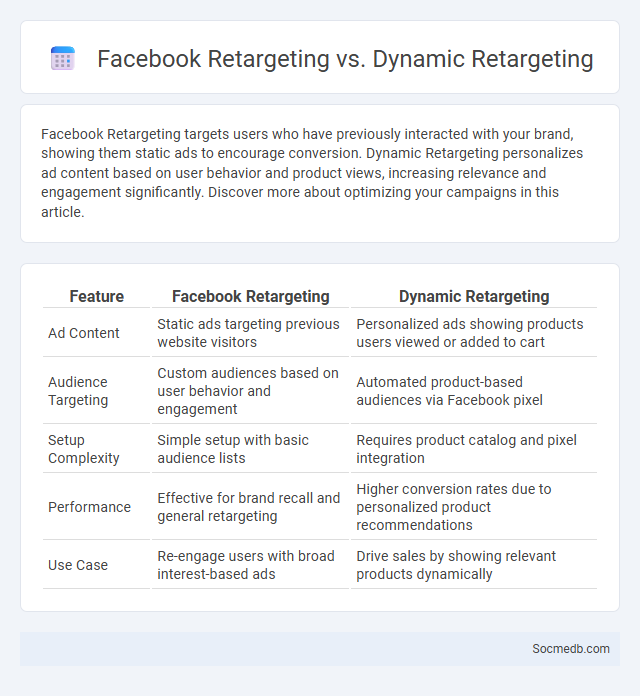
Photo illustration: Facebook Retargeting vs Dynamic Retargeting
Facebook Retargeting targets users who have previously interacted with your brand, showing them static ads to encourage conversion. Dynamic Retargeting personalizes ad content based on user behavior and product views, increasing relevance and engagement significantly. Discover more about optimizing your campaigns in this article.
Table of Comparison
| Feature | Facebook Retargeting | Dynamic Retargeting |
|---|---|---|
| Ad Content | Static ads targeting previous website visitors | Personalized ads showing products users viewed or added to cart |
| Audience Targeting | Custom audiences based on user behavior and engagement | Automated product-based audiences via Facebook pixel |
| Setup Complexity | Simple setup with basic audience lists | Requires product catalog and pixel integration |
| Performance | Effective for brand recall and general retargeting | Higher conversion rates due to personalized product recommendations |
| Use Case | Re-engage users with broad interest-based ads | Drive sales by showing relevant products dynamically |
Understanding Retargeting: An Overview
Retargeting is a powerful social media marketing strategy that targets users who have previously interacted with a brand's content or website but did not convert. By leveraging cookies and pixel tracking technologies, advertisers can deliver personalized ads to these potential customers across platforms such as Facebook, Instagram, and Twitter. This approach increases conversion rates and ROI by re-engaging high-intent audiences with relevant messaging and offers.
What is Facebook Retargeting?
Facebook Retargeting uses pixel tracking to identify website visitors and deliver personalized ads based on their previous interactions. This strategy improves conversion rates by targeting users who already showed interest in Your products or services, increasing the likelihood of engagement. By leveraging data-driven insights, Facebook Retargeting enhances ad relevance and boosts return on ad spend (ROAS).
Introduction to Dynamic Retargeting
Dynamic retargeting on social media leverages user data to deliver personalized ads based on previous interactions, boosting conversion rates by targeting potential customers with relevant content. Platforms like Facebook and Instagram use machine learning algorithms to automatically showcase products users have shown interest in, increasing engagement and driving sales. This strategy enhances marketing ROI by connecting brand messages to consumers in real-time, adapting to their behavior across multiple devices.
Key Differences: Standard Retargeting vs Dynamic Retargeting
Standard Retargeting targets users based on their previous interactions with your website by showing static ads featuring generic products or services, while Dynamic Retargeting uses personalized ads displaying specific items users viewed or added to their cart. Dynamic Retargeting leverages real-time data to tailor content, increasing relevancy and boosting conversion rates compared to Standard Retargeting's broader approach. Utilizing Dynamic Retargeting on your social media platforms maximizes ad efficiency by delivering customized messages that better address Your audience's interests and purchase intent.
How Facebook Retargeting Works
Facebook retargeting works by tracking website visitors through a Facebook Pixel, a piece of code embedded on the site that collects data on user behavior and interactions. When users leave the website without converting, Facebook uses this data to display targeted ads across its platform, including Instagram and Audience Network, reminding users of products or services they viewed. This method increases conversion rates by delivering personalized ads based on past website activity, enhancing advertising efficiency and return on investment for marketers.
Benefits of Dynamic Retargeting for Marketers
Dynamic retargeting enhances ad relevance by automatically showing personalized product recommendations based on users' past interactions, increasing conversion rates by up to 150%. This advanced technique leverages real-time data to deliver tailored content, maximizing your return on ad spend and improving customer engagement. By reconnecting with interested audiences across social media platforms, marketers can effectively reduce cart abandonment and boost sales performance.
Choosing the Right Retargeting Strategy
Selecting the right retargeting strategy involves analyzing audience behavior patterns on platforms like Facebook, Instagram, and LinkedIn to deliver personalized ads that increase conversion rates and reduce ad spend. Utilizing dynamic retargeting, which showcases products users have previously viewed, boosts engagement by up to 50% compared to static ads. Employing frequency capping and segmenting audiences based on interaction stages ensures optimal ad delivery without causing user fatigue or negative brand perception.
Performance Metrics: Measuring Retargeting Success
Tracking key performance metrics such as click-through rates (CTR), conversion rates, and return on ad spend (ROAS) is essential for measuring retargeting success on social media platforms. Analyzing audience engagement and frequency helps optimize budget allocation and improve ad relevance. You can leverage these insights to refine your campaigns and maximize your retargeting ROI effectively.
Common Mistakes in Retargeting Campaigns
Common mistakes in retargeting campaigns include targeting too broad an audience, resulting in wasted ad spend and lower conversion rates. Ignoring frequency caps can lead to ad fatigue, causing your audience to become annoyed and disengaged. You should segment your audience precisely and limit ad frequency to optimize performance and maximize ROI.
Best Practices for Effective Retargeting
Effective retargeting on social media hinges on precise audience segmentation and timely ad delivery to re-engage users who have previously interacted with your brand. Utilizing dynamic ads personalized based on user behavior enhances relevance and increases conversion rates across platforms like Facebook, Instagram, and LinkedIn. Consistent A/B testing of creatives, messaging, and call-to-action elements optimizes campaign performance while adhering to privacy regulations such as GDPR.
 socmedb.com
socmedb.com